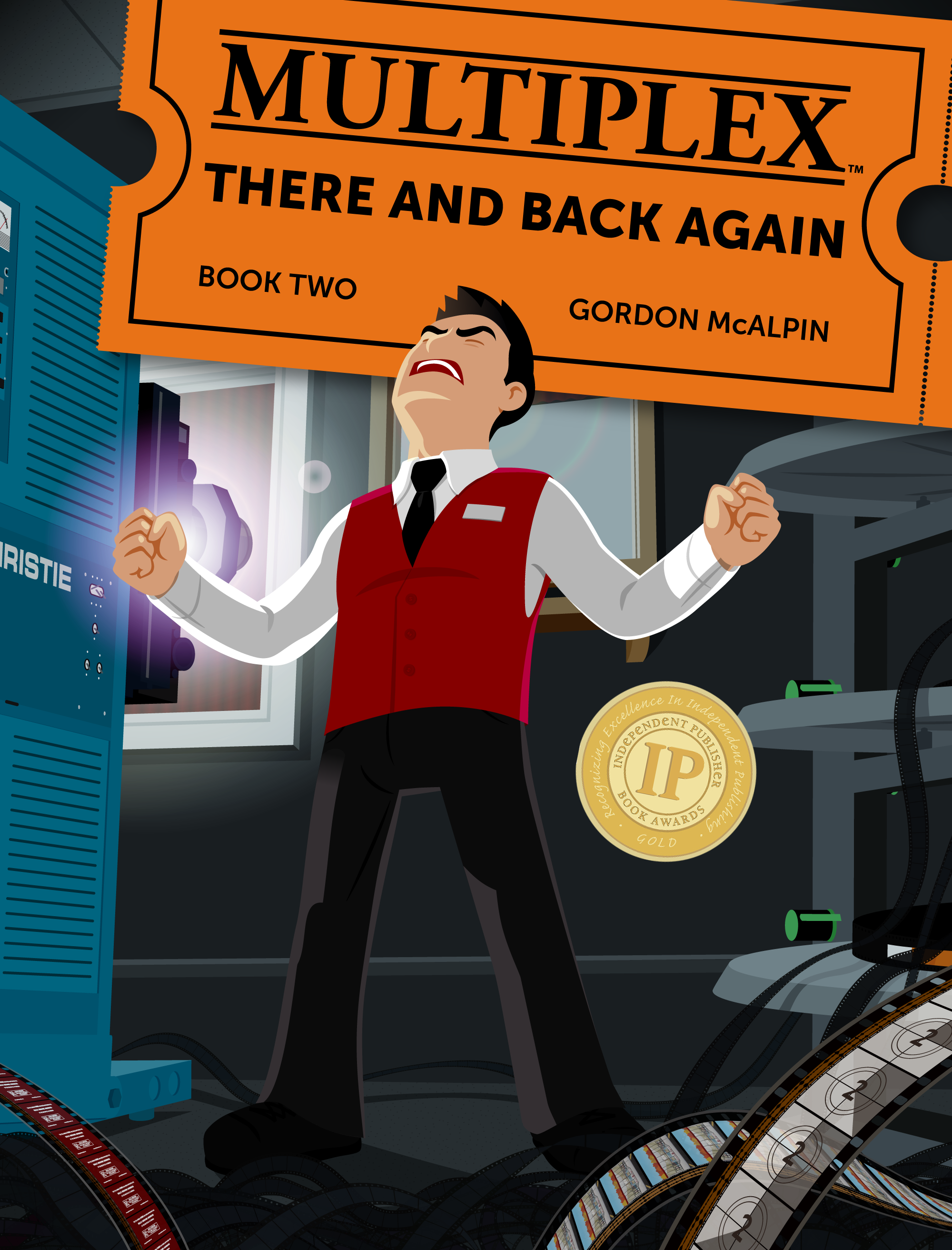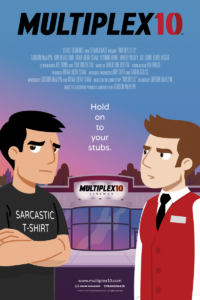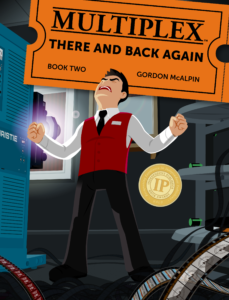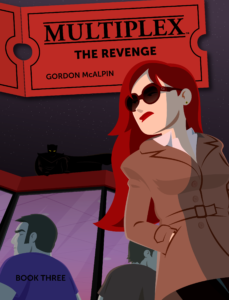Artist Gordon McAlpin wrote the online comic strip Multiplex for twelve years. It has also been published in book format in three volumes.
Michael Habata (MH): Can you talk a little bit about the comic strip Multiplex for people who have never read it, how you created the strip, and how the comic strip has evolved over time?
Gordon McAlpin (GM): Multiplex was an online comic strip that ran from July 2005 through April 2017. It was about the staff of a movie theater, as well as the movies that played there (and movies in general), but most of all the two main characters: Jason, a half-Filipino movie snob, and Kurt, his best friend, whose taste in movies is… far more questionable.
I’d first had the idea — or, rather, my friend Kurt suggested the idea — of doing a comic strip about a movie theater a long time before that, but at the time, I didn’t do anything with it until I was setting up a website for my previous comic strip, Stripped Books (www.strippedbooks.com). Stripped Books was a non-fiction comic that adapted book-related events into comic strip form. Its “features” were eight to twelve pages long, so they took me a while to do, and I decided I wanted it to have a “back-up” feature. I wanted to come up with a gag strip that I could update every week or so, so people would keep visiting the site. Multiplex very quickly became far more popular than Stripped Books ever was, so after about a year, I decided to focus on Multiplex.
As the strip progressed it became less and less gag strippy and focused more on the characters’ lives and them growing up and eventually (spoiler alert!), in the the last couple of years, taking over the movie theater as its managers. It sounds so serious when I describe it like that. It’s really immature, I promise. There are lots of off-color jokes in-between all the high-minded movie talk.
(MH): I think for most people, when they think of “comic strip,” they think of people like Charles Schulz or Bill Watterson doing all the physical work of a comic strip by hand: the initial sketching, the lettering, and inking. What are some common misunderstandings that you think people have about creating comic strips the way that you do? Was it a leap of imagination to create your comic strip using computer design programs?
(GM): Drawing with Illustrator isn’t that much different than drawing by hand, other than the lack of linework. I still sketch and letter — just with Illustrator. I use a graphics tablet and scribble it out, then clean it up with the Pen tool using the mouse, mostly, because it’s more precise. Instead of literally delineating where the objects are with a line, though, I’m using colored shapes stacked on top of colored shapes stacked on colored shapes. (Here’s a YouTube video showing a time lapse of me drawing Enid from Ghost World, so you can see the process: https://www.youtube.com/watch?v=dWQh-RvXKCg )
People often assume that it’s faster or easier to do it this way. And it can be, if you’re just repositioning existing characters almost like digital puppets and then recycling the same backgrounds, which is what I was doing a lot at first. But for almost anything else, like drawing new characters and backgrounds or highly dynamic poses, it’s actually a lot slower. Especially if you’re doing something with any degree of detail. When Jason and Devi visited classic movie theaters, for instance, the exterior shot of the buildings would usually take me around twelve hours to draw.
But that comes with a very clean, crisp, very precise aesthetic that I really enjoy, and they way I use it, I think, makes Multiplex look unique on comics shelves. Obviously, there is a huge range of illustration styles by artists who still use ink and brush (or the Photoshop equivalent), but since comics aren’t required to use those techniques anymore thanks to advances in printing technology (and reading on screens, of course), why not play around with an even wider range of art styles?
(MH): From what I read in earlier interviews, doing the comic strip for you is a part-time job, and your main income comes from graphic design (please correct me if I am remembering incorrectly). How difficult is it to create a comic strip part-time? How do you envision your work as a cartoonist five or ten years from now?
(GM): Well, right now, drawing comics is very much part time, because the strip has ended! But I am working on new material for the fourth Multiplex print book here and there. I am a freelance designer and illustrator for most of my income, though, yeah. In the last couple of years — since I finished grad school — that has been mostly animation work for various clients. Internal corporate videos and food safety videos and things like that, and I was really enjoying that, so last spring, I launched a Kickstarter campaign to fund a Multiplex-based animated short. So that was my full-time job for a few months this year. It is aiming for a January release to video on demand, and a film festival run.
When I was doing the comic on its twice-a-week schedule, with a full-time job, it was pretty exhausting, but you just have to sit down and treat it like a job — because it is one. I would do the comic on Sunday and Thursdays, for the most part, like clockwork.
Comics-wise, I don’t know what I’ll be doing five or ten years from now, to be honest. I have a couple of comics ideas that I need to sit down and work on — one of which is a non-fiction idea, because I’ve missed doing that kind of stuff after Stripped Books ended. And now non-fiction comic books are popular, so it’s probably a good time to try my hand at that again.
(MH): One of the main characters in the Multiplex comic strip is Filipino American, but my sense is that Asian identity and culture are not an integral part of the comic strip, although gender and ethnicity and race all do play small parts. What role do you see ethnicity playing in Multiplex?
(GM): You’re right, Jason’s half-Filipino identity isn’t often the focus of the comic. And that’s partly because he’s based on an exaggerated version of myself. My own Asianness — is that a word? — was something I had a hard time defining and understanding.
I grew up in Peoria, Illinois, and I didn’t really know a lot of other Filipinos there. I’m pretty obviously not white, but I’m also not obviously Filipino. I’m six feet tall and have the most Scottish name on the planet. So in a sense, I was more acutely aware of what I wasn’t — white — than what I was. And it took me a long time to understand that. But it’s literally in my DNA. It’s who I am. And so that informs everything I do, even if it’s sort of filtered through this extra lens of growing up feeling a little bit disconnected from… well, everybody around me.
I read Alex Tizon’s Big Little Man: In Search of My Asian Self a while back, and it was interesting how much of what he talked about there resonated with me and sort of explained some of the things I felt and how I reacted to that when I was younger. I realize now how much being Filipino made me an outsider in some circles — or made me feel like one — and that influenced how I carried myself in it, for better and for worse. If I felt like an outsider, it was going to be on my own terms, and I acted like a know-it-all jerkass. If I felt emasculated by the depiction of Asians (or nerds, or anything else I also identified as) in American media, I was going to reject that stereotype and act, well, a little chauvinistic. I’m very sorry to everyone who knew me when I was younger, by the way.
And that plays out in Jason over the twelve years of the comic strip. He’s a massive jerk early in the strip, and he mellows out over time. Once I decided that Multiplex was going to end, I fashioned it into the kind of coming of age story you could only tell effectively over the course of twelve years, because people don’t really change very suddenly like in so many movies or novels. So while Jason’s Asian identity isn’t the focus of the comic, it’s very much a part of the comic, albeit in not-so-obvious or explicit ways. But, you know, it would be a very lamentable thing if we never had Filipino American protagonists in fiction except in stories explicitly about their Filipino American identity. How is that real representation in media? We have full lives, not all of which revolves explicitly around the fact that we are Asian.
(MH): You have a character called The Blogger, and the dialogue between Jason and Kurt (as well as other characters) about movies and the movie business takes up a large part of the overall conversation in the comic strip. What role do you see criticism as having in the film industry? Are you making a bigger point about the role of critics through Multiplex?
(GM): Haha. The Blogger was great, because he started off as a way for me to make fun of self-important internet film critics, but then I found it more and more interesting to make him an actual human character, and he ended up being really central to the ending of the comic.
But no, I’m not really commenting about film critics in general with him. If anything, I was somewhat taking a jab at the usually internet-based film critics who are, in my opinion, extremely bad at their jobs.
The role of film criticism is, I think, related to but different from film reviewing. You can review a movie without really critiquing it. You can also critique a movie without really “reviewing” it in the sense of giving it a “thumbs up” or “thumbs down” final assessment, I suppose. But to actually answer your question, the internet is a wonderful place because it lets anybody publish a stupid comic and have their opinion. The problem is that not everybody’s opinion is worth knowing. And not everybody can express an opinion in a way that is worth reading or watching. Don’t get me started about YouTube film reviewers who literally just ramble at their webcam about a movie.
A lot of people don’t understand the difference between saying whether or not a movie is good or bad and saying why it is good (or bad). Reviews do the former, criticism does the latter. Great film reviewers tend to do a bit of both. Academics tend to just focus on the criticism. I think they’re both valid approaches.
(MH): I understand that you have been working on an animated short based on the Multiplex comic strip. Could you tell me more about the short, and what it will be like?
(GM): Multiplex 10 is an eleven-minute animated short about how Jason started working at the Multiplex 10 Cinemas. I called it Multiplex 10 rather than Multiplex, mostly to separate it from the comic, because while it is about how Kurt and Jason met, it’s also a reboot and set in the present day. We’re sort of presenting it as a pilot, because I would love more than anything to do more of these longer stories with these characters.
Tonally, it’s very much like the comic strip: it has a very dry sense of humor, lots of movie references, and some really crude/dumb jokes, but at its heart, it’s about movies and how we talk about movies. But unlike the comic, there’s music and sound and editing, so while the characters and the sense of humor are familiar, I’m playing with a whole new box of crayons! I’d like to mention that composer, Tangelene Bolton (http://www.tangelenebolton.com) — who is coincidentally also Filipino with a very not-Filipino name — has done an amazing job with the really eclectic score for this short.
(MH): This article is intended for an audience of Asian American and Pacific Islander librarians. Could you talk about what role libraries have played for you, either for your formal education or professional work?
(GM): I’m a bit of a book collector, so I have a bad habit of buying most of the books I want to read rather than borrowing them from the library. Though relatively recently, I’ve discovered the joys of borrowing digital comics through the Boston Public Library, so I’m reading a lot more comics that I wouldn’t be inclined to buy and put on a shelf — like superhero comics that I know I’ll only read once, for instance.
But when I was in grad school while working on my MFA thesis project, which was about the Twin Cities movie theater industry during the transition from silent to sound cinema (http://www.turnoutthestars.org), I probably visited libraries more than I ever have as an adult. I used them to check out ancient, decaying copies of movie theater industry trade journals and academic journal articles, not to mention the University of Minnesota’s special collections (or the Minnesota Historical Society) which housed a lot of photos of old buildings. So for me, they are more about providing access to knowledge that… you know, isn’t profitable. Book publishers would be more than happy for readers to have to pay for everything they want to read, of course. But you’re not going to publish collections of old newspapers and historical photos and other artifacts. And books fall out of print for a reason: because there’s not enough of a financial incentive to make them available.
So libraries are about democratizing knowledge for me. I’d love to see the Multiplex books in a library, because in a sense, over the twelve years it ran, it became a time capsule. The movie theater industry changed more dramatically with the shift from film to digital than from any other development in its history besides that sound transition. And Multiplex is a bit of a hard sell. It’s not the kind of premise or approach that immediately appeals to most comic book readers. It’s not a big action story, and it’s not this super dramatic, introspective work (although it does occasionally get dramatic). It’s about ideas. And I think libraries are a wonderful home for books exactly like that, where someone can say, “Hey, this is good. It might surprise you.”
I’m @gmcalpin on both Instagram and Twitter, and I post stuff to the https://www.facebook.com/Multiplex10 Facebook page.
My portfolio website is www.gordonmcalpin.com, and of course the Multiplex websites are good to link to: www.multiplexcomic.com for the comic and books and www.multiplex10.com for the animated short.
Editing assistance provided by Silvia Lew.





